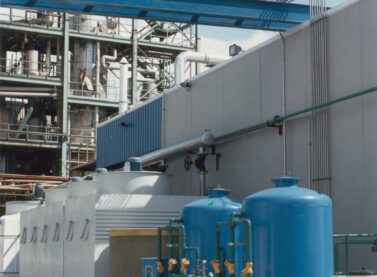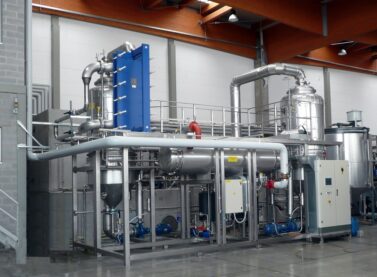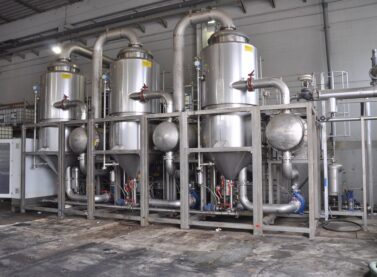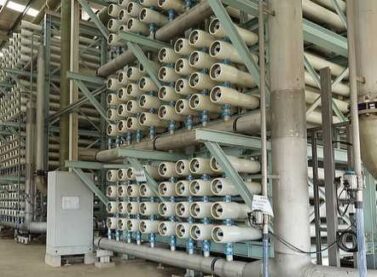Condorchem Envitech Offer
Condorchem has extensive experience in water treatment, we are one of the best water treatment companies in this sector, and offers a wide variety of techniques for pre-treatment and post-treatment of water. The preference for one or another technique depends on the conditions of each particular case, after an analysis by Condorchem Envitech supported by its long history.
Among the most important techniques that Condorchem Envitech applies in purification processes it designs and implements are the following:
Water treatment plants
Concept (need and benefits)
Condorchem offers solutions for water pre-treatment, the production of ultrapure water (purification) and water supply. We apply the necessary treatment to water collected from the natural environment to guarantee its maximum quality before being used in an industrial process.
Depending on the desired use for the water, it is sometimes advisable to pre-treat the water to refine its quality and make it appropriate for its subsequent use. This is not always due to changing the water quality, sometimes it is required that its physical properties are constant over time, and the treatment is a guarantee that there will be no variation in its physical properties.
The most common water pre-treatment types are related to removing hardness, salts, all dissolved species (e.g. iron, manganese or nitrates), unpleasant odors and tastes, dissolved gases and pathogens.
There are also situations when water has to be refined as a stage after an earlier purification process, known as post-treatment. Post-treatment allows the previously treated water to be suitable for a more specific use. This is the case with the remineralization of water after a reverse osmosis process to make it suitable as an intake or for chemical disinfection when produced as drinking water.
Both pre-treatment and post-treatment depend to a great extent on each case, specifically on the quality of the water and the specific use it will have.
Condorchem Envitech also offers efficient solutions for wastewater treatment from industrial production, such as process water, cleaning water, brine and oily water.
Wastewater must be treated to remove the physical, chemical and/or biological contaminants it contains. Wastewater is treated so it can be re-used (zero discharge) or returned to the natural environment without causing any environmental impact. The most suitable treatment for wastewater depends on its state and the desired quality of the treated water.
In the primary treatment, coarse solids, sands, oils and fats are removed from the wastewater. During secondary treatment, the organic matter and sometimes the nitrogen in the water is broken down. Finally, contaminants still present which are a disadvantage for the use of this water (e.g. nutrients, suspended solids or pathogens) are removed in the tertiary treatment.
Processes
The most common processes used to make water suitable for use are the following:
- Softening or decalcification: To remove calcium and magnesium ions dissolved in the water, which give it its hardness and prevent numerous uses of the water.
- Demineralization: To remove all salts dissolved in water. This process is required when water of a certain purity is required.
- Denitrification: Which removes nitrates dissolved in the water. This must be done for practically any use required of water.
- De-ironing: To remove iron and manganese ions dissolved in the water, which colors the water and leads to precipitation.
- Desalination: To remove all salt in the water, especially sodium and chlorine ions, to transform sea water or brine into high quality water.
- Removal of color, odor and taste: By removing the compounds that contribute to these unwanted organoleptic properties of the water
- Remineralization: To add ions to high purity water, often obtained by reverse osmosis, to make it potable. Its consumption would otherwise lead to an osmotic imbalance in the body.
Technologies
The most efficient and, therefore, most suitable technologies used in water pre-treatment are described below:
- Ion exchange: Ion exchange retains and separates desired cations and anions in the water using the appropriate resins. Thus, it removes hardness (calcium and magnesium cations), nitrates and other components.
- Electrodeionization: This process removes most dissolved impurities from the water using ion exchange membranes and electricity, producing demineralized water.
- Microfiltration, ultrafiltration and nanofiltration: Filtration separates particles suspended in the water according to their size. Microfiltration retains particles with a diameter of 0.1-10 µm (e.g. macromolecules and colloids); ultrafiltration is for particles of 0.001-0.1 µm (e.g. macroproteins and antibiotic viruses); and nanofiltration, for particles with a size of 0.1-1 nm (e.g. heavy metals and color).
- Reverse osmosis: Reverse osmosis produces high quality water with hardly any impurities. Only small, uncharged chemical species can cross the reverse osmosis membrane.
- Adsorption: This process makes it possible to separate molecules that give water its color, odor or taste. Activated carbon is the most commonly used adsorbent, although more specific adsorbents can be used depending on the application.
Water types
If the water is already of an acceptable quality, it will not usually be necessary to subject it to any treatment. However, in the case of hard water, saline waters, water with high concentrations of nitrates, iron or manganese, for example, a specific treatment should be designed to correct the necessary parameter and ensure the water is suitable for a specific use.
The following types of water usually require a pre-treatment or post-treatment stage:
- Hard or very hard water (high concentration of calcium and/or magnesium)
- Water with a high dissolved solids content
- High nitrate content
- High iron and/or manganese content
- High salt content or brackish water
- Water with unsatisfactory organoleptic properties (this needs pre-treatment for the catering sector)
- Excessively pure water, requiring remineralization before drinking
Sectors and applications
Pre-treatment and post-treatment of water are processes demanded by a wide variety of industrial sectors. They are indispensable, for example, for water used to feed boilers, water added to finished food (e.g. beer, soft drinks, isotonic drinks and broths), potable water and that for use in closed refrigeration circuits.
As water treatment equipments manufacturers we know the most important industrial sectors requiring water pre-treatment are the following:
- Food industry, to eliminate hardness, minerals and unpleasant odors or flavors.
- Electronics and materials industry, to remove all water impurities.
- Chemical and pharmaceutical industry, to remove hardness, minerals, dissolved species or all impurities, depending on the particular case.
- Drinking water, to remineralize water that is very pure and to remove dissolved species, such as nitrates, iron or manganese, if their content is moderate or high.
- Textile industry, to remove dissolved species.
- Paint and pigment industry, to remove all impurities.
- Energy production plants and the oil and gas sector, to obtain pure water.








